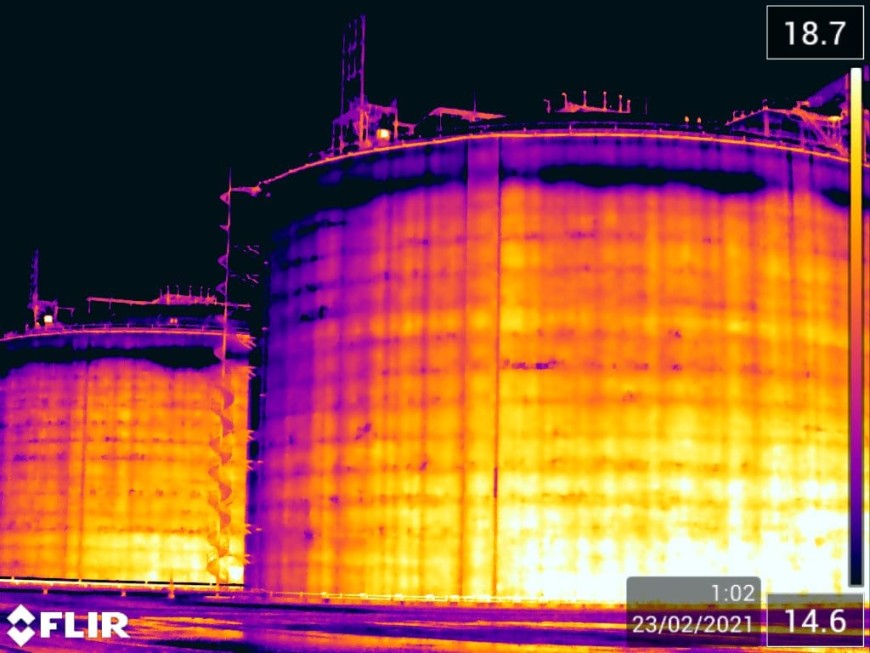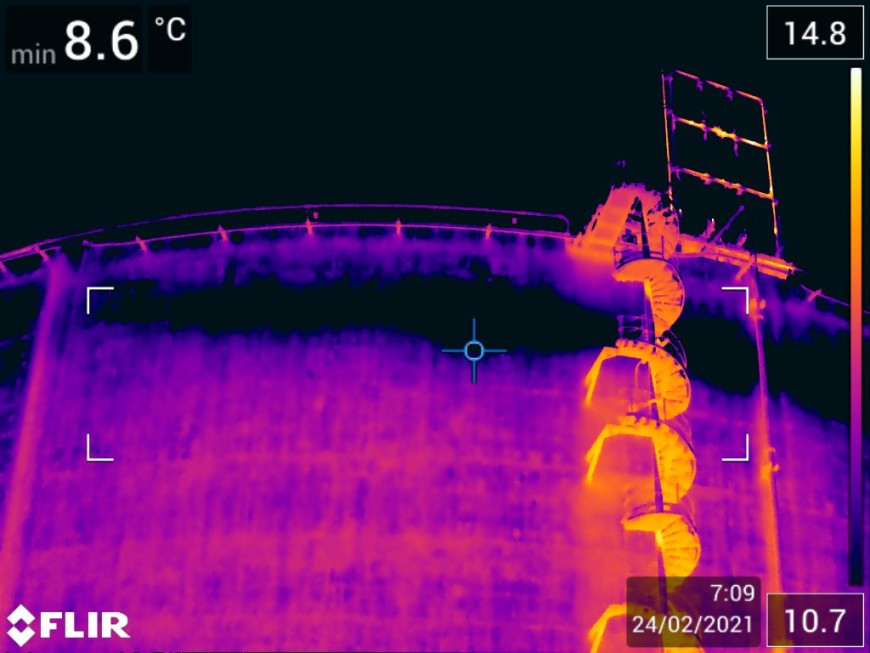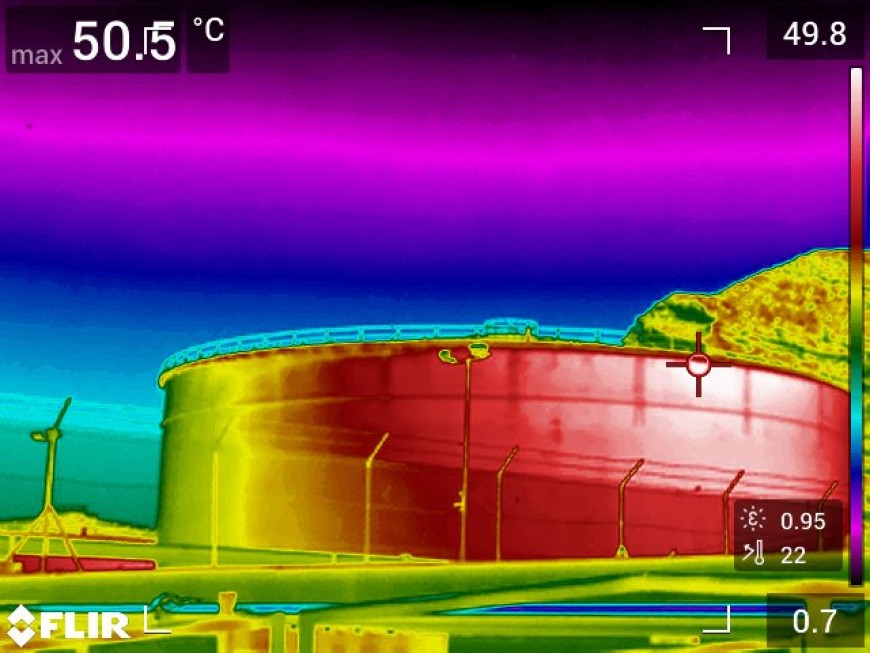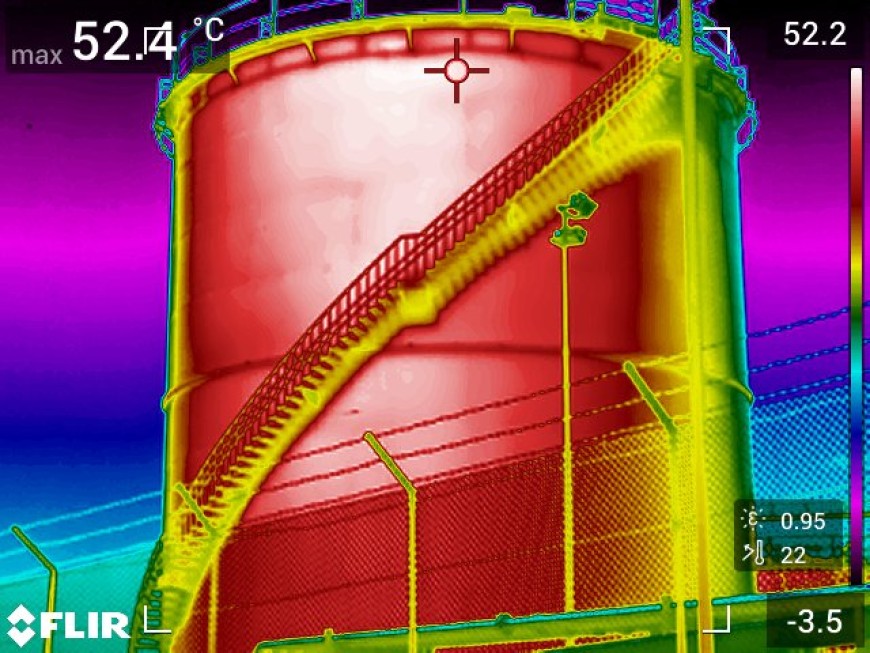Oil & Gas Tanks/ Separators Sludge Detection
Thermography is an excellent technology to monitor active, large, cryogenic storage tanks. This approach proposes to use thermography to monitor new or refurbished tanks, prior to filling with cryogenic liquid, to look for insulation voids. Thermography may provide significant cost and schedule savings if voids can be detected early before a tank is returned to service.
Because of the large thermal mass of the inner and outer spheres, heat transfer between surfaces to equalize temperatures can be relatively slow, even when the temperature differences between the spheres themselves is small. Therefore, thermography has been suggested as an aid in acceptance testing of the tanks before cryogen is introduced to any tank, new or refurbished.
The ability to detect insulation voids prior to filling with cryogen will save money and time, eliminating the expense of losing cryogen and the months required for chilling down and warming up the tank if a void is discovered after the cryogen is introduced into the system. Potential savings could be in the millions if large voids are detected early.
Tanks play very important role in manufacturing and process industries. The level of water or other fluids in the tanks has to be monitored and maintained continuously. Thermography helps in detection of fluid level in the tank on basis of thermal inertia. Insulation losses and defective insulation in the walls of the storing tanks can be detected by using a thermal imaging camera with good sensitivity and can avoid cracks and failures in the tanks.
Online condition monitoring systems are used to assess the health and performance of equipment and machinery in real-time. These systems employ various techniques and technologies to monitor parameters such as temperature, vibration, pressure, and more. Here are some different types of online condition monitoring systems:
Vibration Monitoring Systems: These systems measure and analyze vibrations to detect faults and abnormalities in rotating machinery like motors, pumps, compressors, and turbines. They utilize accelerometers, proximity probes, or other sensors to capture vibration data and perform analysis for early fault detection.
Temperature Monitoring Systems: Temperature monitoring systems track the temperature of equipment and critical components to identify overheating or abnormal temperature patterns. They use temperature sensors and may include features like thermal imaging to visualize temperature distributions.
Oil Analysis Systems: These systems monitor the condition of lubricating oils used in machinery. They analyze oil samples for various parameters such as viscosity, contaminants, and wear debris to assess the health of the equipment and detect potential issues like lubricant degradation or component wear.
Pressure Monitoring Systems: Pressure monitoring systems are employed to monitor pressure levels in systems such as hydraulic systems, pipelines, and boilers. They utilize pressure sensors to detect abnormalities like pressure drops, leaks, or excessive pressure, which may indicate faults or performance issues.
Electrical Monitoring Systems: Electrical monitoring systems assess the electrical parameters of equipment, such as voltage, current, power factor, and harmonics. They help identify electrical faults, power quality issues, and abnormal operating conditions that can affect the performance and lifespan of electrical components.
Ultrasound Monitoring Systems: Ultrasound-based monitoring systems detect high-frequency sound waves emitted by equipment. They can identify issues like leaks, electrical discharge, bearing defects, and steam traps. Ultrasound monitoring is particularly useful for detecting early-stage faults and can be used alongside other monitoring techniques.
Infrared Thermography Systems: Infrared thermography systems use thermal cameras to measure and visualize temperature variations in equipment. They help identify hotspots, thermal irregularities, and abnormal heat patterns, which may indicate electrical faults, insulation problems, or friction in mechanical components.
Data Analytics and Machine Learning Systems: These systems incorporate advanced data analytics and machine learning algorithms to process and analyze large volumes of sensor data from various monitoring systems. They can detect patterns, trends, and anomalies, enabling predictive maintenance and early fault detection.
It’s worth noting that many online condition monitoring systems integrate multiple techniques and sensors to provide comprehensive monitoring and diagnostic capabilities for different types of equipment. The specific choice of monitoring system depends on the type of machinery, critical parameters, and the desired level of monitoring detail and accuracy.






